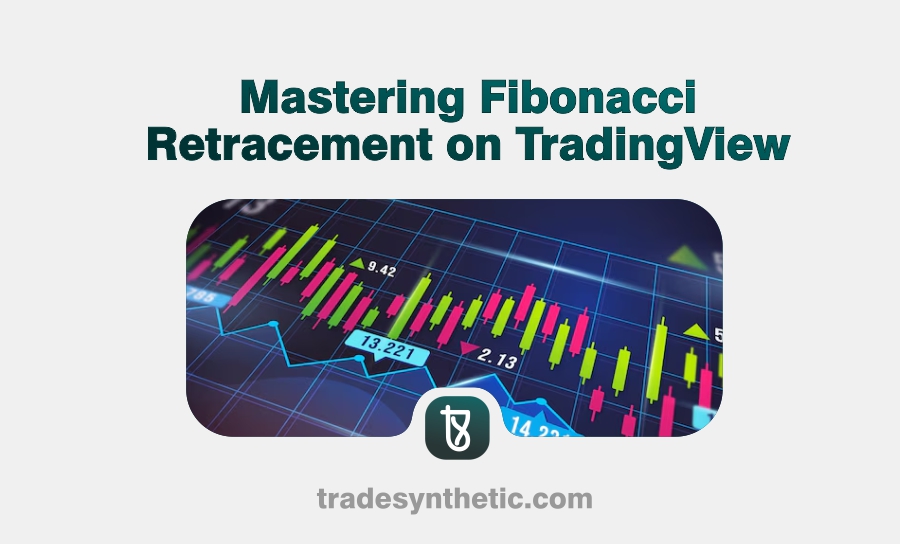When it comes to technical analysis, knowing how to use Fibonacci Retracement on TradingView can be a powerful way for traders to identify key price levels with precision. Irrespective of what you’re trading forex, stocks, or cryptocurrencies, this tool helps pinpoint potential support and resistance zones, allowing you to make informed decisions.
In this article, you will discover how to effectively use Fibonacci retracement on TradingView, integrate it with other indicators, and maximize your trading strategy for better results.
What is Fibonacci Retracement?
Fibonacci retracement is based on the Fibonacci sequence, a series of numbers where each number is the sum of the two preceding ones. In trading, key Fibonacci levels—such as 23.6%, 38.2%, 50%, 61.8%, and 100%—are derived from this sequence. These levels represent potential areas where a security’s price may experience support or resistance.
When a market experiences a significant price movement, either upward or downward, it often retraces a portion of that move before continuing in the original direction. Traders use Fibonacci retracement levels to identify these potential reversal points, allowing for more informed decision-making.
Setting Up Fibonacci Retracement on TradingView
To effectively use Fibonacci retracement on TradingView, follow these steps:
- Select the Fibonacci Retracement Tool: On the TradingView chart, click on the ‘Drawings’ toolbar on the left side. Under the ‘Fib & Gann’ section, select ‘Fibonacci Retracement’.
- Identify the Trend: Determine the significant high and low points of the price movement. For an uptrend, click at the low point and drag to the high point. For a downtrend, start at the high point and drag to the low point.
- Adjust the Levels: Once the Fibonacci retracement is plotted, you can customize the levels. Right-click on the retracement lines, select ‘Settings’, and modify the levels and colors as per your preference.
- Analyze the Chart: Observe how the price interacts with the Fibonacci levels. These interactions can provide insights into potential support and resistance areas.
Integrating Fibonacci Retracement with Other Indicators
While Fibonacci retracement is a valuable tool, combining it with other technical indicators can enhance its effectiveness:
- Moving Averages: Overlay moving averages to identify the overall trend direction. Confluences between Fibonacci levels and moving averages can signify stronger support or resistance zones.
- Relative Strength Index (RSI): Use RSI to assess the momentum of the price movement. An overbought or oversold RSI at a Fibonacci level may indicate a potential reversal.
- Candlestick Patterns: Analyze candlestick formations at Fibonacci levels to gain insights into market sentiment and potential reversals.
Common Mistakes to Avoid When Using Fibonacci Retracement on TradingView
While Fibonacci retracement is a valuable tool, many traders make common mistakes that can lead to inaccurate analysis and poor trading decisions. Here are some key pitfalls to avoid:
-
Forcing Fibonacci Levels on the Chart – One major mistake is applying Fibonacci retracement to random price movements without identifying a clear trend. Always ensure you’re using it in the right market conditions—either during a strong uptrend or downtrend.
-
Ignoring Higher Time Frames – Focusing only on short-term charts can lead to misleading signals. Always check Fibonacci levels across multiple time frames to confirm significant support and resistance areas.
-
Using Fibonacci Alone – Relying solely on Fibonacci retracement without combining it with other indicators (like moving averages, RSI, or candlestick patterns) can reduce its accuracy. Use it as part of a broader technical analysis strategy.
-
Misplacing the Fibonacci Tool – Incorrectly selecting swing highs and swing lows when drawing Fibonacci retracement can lead to inaccurate levels. Always start from the lowest point to the highest in an uptrend and from the highest to the lowest in a downtrend.
-
Ignoring Market Context – Economic events, news, and market sentiment can override technical analysis. Always consider fundamental factors before making trading decisions based on Fibonacci retracement.
Practical Tips for Using Fibonacci Retracement on TradingView
To maximize the benefits of Fibonacci retracement on TradingView:
- Combine Time Frames: Analyze multiple time frames to identify significant Fibonacci levels that align across different periods, increasing their reliability.
- Set Alerts: Utilize TradingView’s alert feature to notify you when the price approaches key Fibonacci levels, allowing for timely decision-making.
- Practice Risk Management: Always use stop-loss orders and manage your position sizes to mitigate potential losses, especially when trading near Fibonacci levels.
Conclusion
In summary, mastering Fibonacci retracement on TradingView can significantly enhance your trading strategy by identifying potential reversal points and support/resistance levels. Integrating this tool with other technical indicators and practicing sound risk management will help you to make more informed trading decisions. Always remember, continuous practice and analysis are key to effectively utilizing Fibonacci retracement in your trading endeavors.
Frequently Asked Questions
What is the significance of the 61.8% Fibonacci level?
- The 61.8% level, often referred to as the “golden ratio,” is considered a strong indicator of potential reversal. Prices frequently retrace to this level before continuing in the original direction.
Can Fibonacci retracement be used for all types of markets?
- Yes, Fibonacci retracement can be applied to various markets, including stocks, forex, commodities, and cryptocurrencies, as it analyzes price movements common across different asset classes.
How reliable are Fibonacci retracement levels in predicting market movements?
- While Fibonacci retracement levels are widely used and can provide valuable insights, they should not be relied upon solely. Combining them with other technical analysis tools and indicators increases their effectiveness.
Is it possible to customize Fibonacci retracement levels on TradingView?
- Yes, TradingView allows users to customize Fibonacci retracement levels. You can add or remove levels, change colors, and adjust line styles to suit your analysis preferences.
How do I remove Fibonacci retracement from my TradingView chart?
- To remove the Fibonacci retracement tool from your chart, simply click on the retracement lines to select them and press the ‘Delete’ key on your keyboard, or right-click and choose ‘Remove’.










